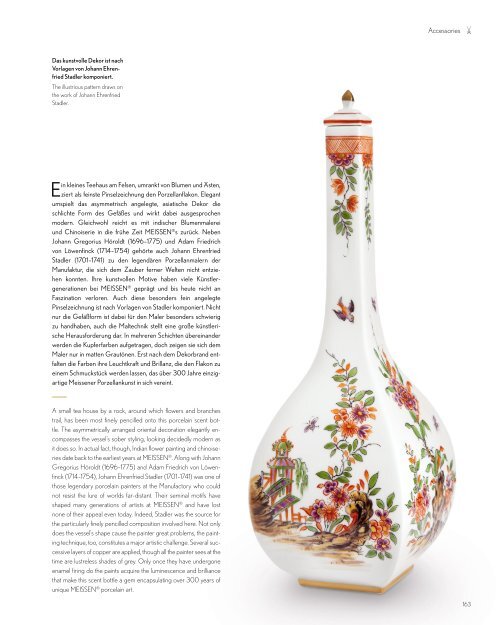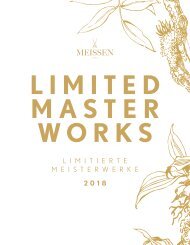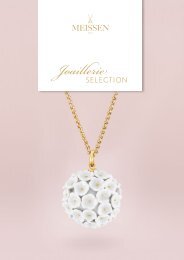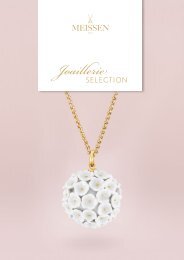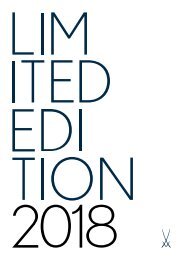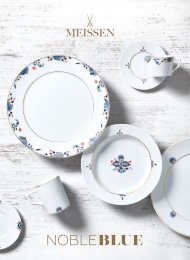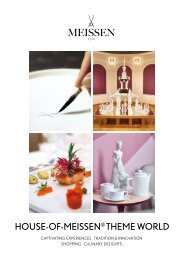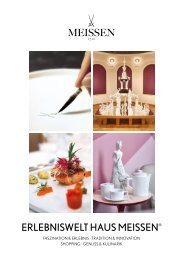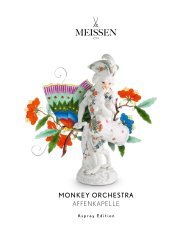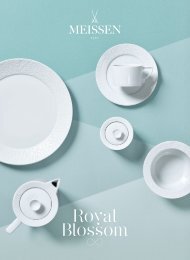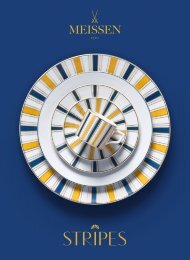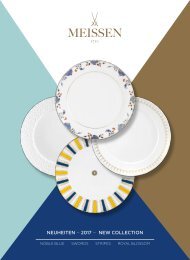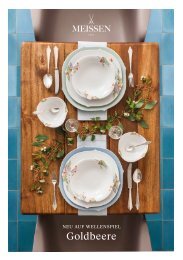MEISSEN Limitiere Kunstwerke 2017
Sie wollen auch ein ePaper? Erhöhen Sie die Reichweite Ihrer Titel.
YUMPU macht aus Druck-PDFs automatisch weboptimierte ePaper, die Google liebt.
Accessories<br />
Das kunstvolle Dekor ist nach<br />
Vorlagen von Johann Ehrenfried<br />
Stadler komponiert.<br />
The illustrious pattern draws on<br />
the work of Johann Ehrenfried<br />
Stadler.<br />
Ein kleines Teehaus am Felsen, umrankt von Blumen und Ästen,<br />
ziert als feinste Pinselzeichnung den Porzellanflakon. Elegant<br />
umspielt das asymmetrisch angelegte, asiatische Dekor die<br />
schlichte Form des Gefäßes und wirkt dabei ausgesprochen<br />
modern. Gleichwohl reicht es mit indischer Blumenmalerei<br />
und Chinoiserie in die frühe Zeit <strong>MEISSEN</strong> ® s zurück. Neben<br />
Johann Gregorius Höroldt (1696–1775) und Adam Friedrich<br />
von Löwenfinck (1714–1754) gehörte auch Johann Ehrenfried<br />
Stadler (1701–1741) zu den legendären Porzellanmalern der<br />
Manufaktur, die sich dem Zauber ferner Welten nicht entziehen<br />
konnten. Ihre kunstvollen Motive haben viele Künstlergenerationen<br />
bei <strong>MEISSEN</strong> ® geprägt und bis heute nicht an<br />
Faszination verloren. Auch diese besonders fein angelegte<br />
Pinselzeichnung ist nach Vorlagen von Stadler komponiert. Nicht<br />
nur die Gefäßform ist dabei für den Maler besonders schwierig<br />
zu handhaben, auch die Maltechnik stellt eine große künstlerische<br />
Herausforderung dar. In mehreren Schichten übereinander<br />
werden die Kupferfarben aufgetragen, doch zeigen sie sich dem<br />
Maler nur in matten Grautönen. Erst nach dem Dekorbrand entfalten<br />
die Farben ihre Leuchtkraft und Brillanz, die den Flakon zu<br />
einem Schmuckstück werden lassen, das über 300 Jahre einzigartige<br />
Meissener Porzellankunst in sich vereint.<br />
A small tea house by a rock, around which flowers and branches<br />
trail, has been most finely pencilled onto this porcelain scent bottle.<br />
The asymmetrically arranged oriental decoration elegantly encompasses<br />
the vessel’s sober styling, looking decidedly modern as<br />
it does so. In actual fact, though, Indian flower painting and chinoiseries<br />
date back to the earliest years at <strong>MEISSEN</strong> ® . Along with Johann<br />
Gregorius Höroldt (1696–1775) and Adam Friedrich von Löwenfinck<br />
(1714–1754), Johann Ehrenfried Stadler (1701–1741) was one of<br />
those legendary porcelain painters at the Manufactory who could<br />
not resist the lure of worlds far-distant. Their seminal motifs have<br />
shaped many generations of artists at <strong>MEISSEN</strong> ® and have lost<br />
none of their appeal even today. Indeed, Stadler was the source for<br />
the particularly finely pencilled composition involved here. Not only<br />
does the vessel’s shape cause the painter great problems, the painting<br />
technique, too, constitutes a major artistic challenge. Several successive<br />
layers of copper are applied, though all the painter sees at the<br />
time are lustreless shades of grey. Only once they have undergone<br />
enamel firing do the paints acquire the luminescence and brilliance<br />
that make this scent bottle a gem encapsulating over 300 years of<br />
unique <strong>MEISSEN</strong> ® porcelain art.<br />
163


